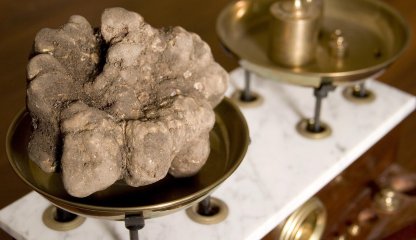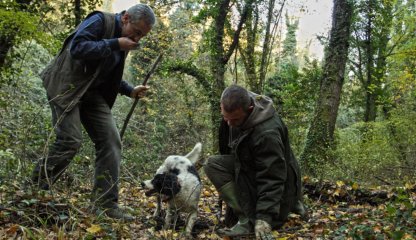Truffle of San Miniato
San Miniato: one of Europe’s most prosperous and expansive areas for truffles
It’s the star of Tuscan autumn: the truffle.
A truffle can essentially be defined as a hypogeum (underground) fungus; the term refers to a fruiting body that the fungus’ vegetative system produces each year for the propagation of the species.
San Miniato is one of Europe’s most expansive and prosperous areas for truffles, and the white truffle of San Miniato hills, the Tuber Magnatum Pico, is the most prestigious.
Its dimensions vary and it has a pleasant but strong aroma, resembling the scent of fermented cheese.
Production area
The San Miniato hills are a perfect environment for the growth of the Tuber Magnatum Pico (the scientific name for the famous white truffle). The vegetation and trees of the area generate in fact an ideal climate and an ecosystem left uncontaminated. Here a substantial truffle harvest takes place between September and December, yielding dozens and dozens of kilograms’ worth.
Between January and April, however, in the same area, it’s time for the Marzuolo Truffle (Tuber Albidum Pico); from May to September, the Scorzone black truffle (Tuber Aestivum Vitt.).
The towns home to the “tuber” straddle the areas of Pisa and Florence. Among them are Bientina, Capannoli, Chianni, Lajatico, Lari, Palaia, Volterra, Barberino Val d'Elsa, Cerreto Guidi, Certaldo, Gambassi, Montaione and Montespertoli.
The San Miniato hills are a perfect environment for the growth of the Tuber Magnatum Pico (the scientific name for the famous white truffle). The vegetation and trees of the area generate in fact an ideal climate and an ecosystem left uncontaminated. Here a substantial truffle harvest takes place between September and December, yielding dozens and dozens of kilograms’ worth.
Between January and April, however, in the same area, it’s time for the Marzuolo Truffle (Tuber Albidum Pico); from May to September, the Scorzone black truffle (Tuber Aestivum Vitt.).
The towns home to the “tuber” straddle the areas of Pisa and Florence. Among them are Bientina, Capannoli, Chianni, Lajatico, Lari, Palaia, Volterra, Barberino Val d'Elsa, Cerreto Guidi, Certaldo, Gambassi, Montaione and Montespertoli.
San Miniato truffle hunters’ association
Regulated by a strict policy and by a regional law that clearly sets the terms for harvesting and sales, the White Truffle of San Miniato has been well-known since medieval times, but it’s only in the last 100 years or so that the harvesting activities have been organized by domestic groups, known as the tartufai, or truffle hunters.
In 1982 in San Miniato, the Associazione Tartufai delle Colline Sanminiatesi (San Miniato truffle hunters’ association) was founded, Tuscany’s largest group of its kind and the second largest at the national level. Its goal is to protect the product and safeguard its environment, aiming continually to valorize the long history and culture of the truffle.
Truffle hunting is not a trade for just anyone, it’s a skill that’s generally passed down in families from generation to generation. It’s been this way for years in San Miniato, too.
Fundamental to this enterprise are truffle hunting dogs, who faithfully accompany their masters on the quest for this hidden treasure in the deep woods of the San Miniato hills.
Regulated by a strict policy and by a regional law that clearly sets the terms for harvesting and sales, the White Truffle of San Miniato has been well-known since medieval times, but it’s only in the last 100 years or so that the harvesting activities have been organized by domestic groups, known as the tartufai, or truffle hunters.
In 1982 in San Miniato, the Associazione Tartufai delle Colline Sanminiatesi (San Miniato truffle hunters’ association) was founded, Tuscany’s largest group of its kind and the second largest at the national level. Its goal is to protect the product and safeguard its environment, aiming continually to valorize the long history and culture of the truffle.
Truffle hunting is not a trade for just anyone, it’s a skill that’s generally passed down in families from generation to generation. It’s been this way for years in San Miniato, too.
Fundamental to this enterprise are truffle hunting dogs, who faithfully accompany their masters on the quest for this hidden treasure in the deep woods of the San Miniato hills.
Fun facts
- Nicknamed “Cibo da Re” (Kings’ Food), the White Truffle is celebrated in a major fair and exhibition every November: National White Truffle Exhibition in San Miniato.
- The world’s largest white truffle, weighing in at 2,520 kg, was discovered in San Miniato on October 26, 1954 by a truffle hunter from Balconevisi. The story goes that this truffle was gifted to then-U.S. president Dwight D. Eisenhower.
- In terms of cuisine, an absolute must-try is Tagliolino al tartufo bianco delle colline sanminiatesi (San Miniato white truffle tagliolino), a dish that must follow very specific rules: the dough for the tagliolini must be prepared with soft wheat flour or durum wheat bran, and the ingredients cannot contain any artificial aromas.
- Nicknamed “Cibo da Re” (Kings’ Food), the White Truffle is celebrated in a major fair and exhibition every November: National White Truffle Exhibition in San Miniato.
- The world’s largest white truffle, weighing in at 2,520 kg, was discovered in San Miniato on October 26, 1954 by a truffle hunter from Balconevisi. The story goes that this truffle was gifted to then-U.S. president Dwight D. Eisenhower.
- In terms of cuisine, an absolute must-try is Tagliolino al tartufo bianco delle colline sanminiatesi (San Miniato white truffle tagliolino), a dish that must follow very specific rules: the dough for the tagliolini must be prepared with soft wheat flour or durum wheat bran, and the ingredients cannot contain any artificial aromas.





